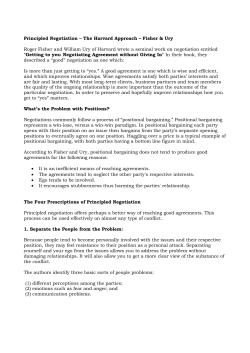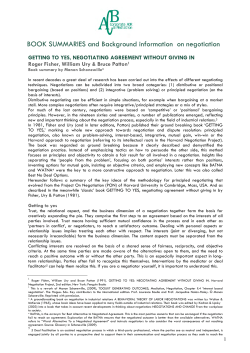
3.3 FlEGT Voluntary partnership agreements
3.3 FLEGT Voluntary Partnership Agreements Melissa Othman, IOla Leal, Didier Devers and LEa Turunen The European Union (EU) enacted the Forest Law Enforcement, Governance and Trade (FLEGT) Action Plan in 2003 as part of the worldwide effort to address illegal logging and its negative consequences.1 The EU FLEGT Action Plan sets out a range of measures to tackle illegal logging and its associated trade and to promote forest sector governance. The Action Plan recognizes the role of timber-consuming and timber-producing countries, and defines a set of actions for both to contribute efforts to fight illegal logging. Voluntary Partnership Agreements (VPAs), one of the instruments proposed in the plan, are trade agreements negotiated between a timber-exporting country (the FLEGT partner country) and the EU. The agreements are voluntary; a timber-exporting country makes an official government request to engage in one. Unlike other trade agreements, the EU is not positioning for trade preferences. Instead, Multi-stakeholder the two entities work together to strengthen the timber-exporting country’s ability to ensure the participatory processes legal compliance of its timber and timber products. are fundamental to forest sector governance Under the VPA, a FLEGT licence is issued to confirm that the timber product has been checked and to the successful implementation and is in compliance with the requirements set out of the VPA. in the agreement. General principles describing this licensing scheme are outlined in the FLEGT2 regulation, but the details are left to each negotiation. This openness allows each agreement to adapt to the realities and goals of the partner country in terms of forest governance reforms. This openness has its challenges as well. Since no blueprint is provided it is up to each country’s stakeholders — i.e., affected and interested actors in the forest sector, such as government agencies, private-sector operators, forest communities and civil society organizations — to define the detail. Many governments do not have a tradition of openly discussing forest sector reform with civil society or the private sector, so such consensus forming and engagement is new and can be difficult for many countries (Box 1). Melissa Othman, Iola Leal, Didier Devers and Lea Turunen work for EFI in its EU FLEGT Facility. 109 ETFRN News 53: April 2012 Box 1. The Cameroon VPA The process to conclude the Cameroon-EU VPA lasted five years. Negotiations helped reinforce ongoing governance reforms. Although consultation with civil society had a rocky start, the level of civil society involvement had been unprecedented in the country and has led to strong written commitments for reforms of the forest sector. Source: Symphorien Azantsa, Civil society representative in Cameroon VPA, 2010 Even though VPAs have not yet delivered FLEGT licences, VPA negotiation experiences from ten countries3 show that the negotiation process itself is having an impact on forest governance by creating more opportunity for dialogue and providing a framework to strengthen forest control, transparency and accountability. The success of the framework will depend on each country’s ability to advance the actual development and implementation of the structures, systems and commitments agreed to in the VPA, but as a solid first step, the VPA negotiation process has promoted multi-stakeholder agreement on what those systems, structures and commitments should be. Why enter into VPA negotiations? New market requirements related to trade in timber products are causing unprecedented change in the forest sector that no internationally financed forest program, national reform, or individual forest project has been able to achieve. The past decade has seen timber markets become increasingly selective, asking for proof that forest operations, transactions and management promote legal trade. These changes have been in the form of public procurement policies, timber association requirements, company purchasing policies, and even lending criteria on the part of financial institutions to support environmental and socially sound operations. For many countries the main impetus seems to be the U.S. Lacey Act and the European Union Timber Regulation (EUTR), which comes into force March 2013.4 These two pieces of government legislation demand transparency and legality requirements for timber markets. For the first time, there are potentially real consequences for not demonstrating legality when trading in timber. The U.S. and EU are two of the largest timber-consuming markets in the world, so the pressure on the timber trade is immense. The EUTR, another measure in the EU FLEGT Action plan, has made VPAs more attractive to timber-exporting countries. Countries that first entered into VPA negotiations, before the EUTR was legally outlined, had major challenges in selling the concept to their citizens. Many people questioned why the country should invest in so much reform and change if there was no advantage against countries not engaging in a VPA. Once the EUTR legislation was finalized, the market advantage was apparent. Under the EUTR, FLEGT licensed timber can enter EU markets without having to provide any further documentation; this is not the case for timber coming from non-VPA countries. The trade 110 3.3 FLEGT Voluntary Partnership Agreements element therefore provides a great opportunity for governance reform and has become a driving force for change in the sector. VPA elements: building blocks to strengthen forest governance Specific elements of the VPA provide a foundation for strengthening forest governance: • the components to the VPA licensing scheme, often referred to as the Legality Assurance System (LAS),5 which consists of a legality definition, verification procedures, supply chain control, independent audit and licensing; • a structure to oversee and monitor implementation, which many agreements refer to as the Joint Implementation Committee (JIC); and • a list of documents that must be made public. To date, none of these elements are operational in any of the VPA countries, but it is important to recognize the building blocks they provide to strengthen transparency, clarity and accountability. The success of the VPA will depend on each country’s ability to implement these elements, but reaching consensus on how they are designed is in itself an achievement. Legality definition provides legislative clarity Fundamental to the FLEGT licensing scheme is for each country to clearly describe, based on its own national legislation, what is legal timber. This is done through a legality definition (LD). The LD defines the legislative and regulatory requirements that must be complied with and systematically verified to ensure legal compliance before a FLEGT licence can be issued. The LD is the result of multi-stakeholder dialogue, where the various stakeholders come together to discuss priorities, perspectives and concerns. The aim is to agree on requirements that are clear and that represent the entire supply chain and address key priorities. The dialogue is often contentious, as it brings together different agendas and perspectives. Suggestions from the private sector often reflect its desire for a simple licensing system so it can easily demonstrate legality of its product; in some cases, the sector sees the VPA as a tool to reduce the amount of corruption by focusing on requirements in problem areas. On the other hand, civil society often wants to ensure that private companies meet their obligations to surrounding forest communities. These perspectives often clash and it is difficult to find consensus. This means that the process takes time that many governments and privatesector operators do not always want to take. Despite these clashes and pressures, the LD experience has resulted in stakeholders becoming more familiar with the country’s forest legislation. In some countries the LD process has identified where legislative reform is needed because of inconsistencies, overlaps, or gaps in legislation. The resulting LD helps clarify the law and what is required, making it more transparent and interactive. 111 ETFRN News 53: April 2012 Verification procedures: articulating responsibility and ensuring accountability Clear legislation and a secure supply chain are fundamental elements of the VPA. If these are not regularly monitored for compliance, however, they will have limited if any value. Each FLEGT partner country must therefore clearly indicate the different government (and perhaps non-government) institutions involved in the verification of timber legality. It must also set out how controls will take place along the entire timber production and processing chain, detailing the different roles, responsibilities and jurisdictions needed to verify legal compliance. Verification procedures clarify institutional responsibility. This should help the agencies who implement the system better understand their specific role and activities, and should minimize overlap and clarify accountability. The system relies not just on forest agencies, but on inputs from and collaboration with other government agencies, such as customs, trade, environment, justice, finance, labour and health, including certain regional departments within these agencies. Vague, overlapping mandates or procedures open the system to misinterpretation and can undermine its effectiveness and credibility. Institutional coordination is not something that advances quickly, however; such coordination may feel threatening and agency norms and culture may feel at risk, thus making modifications difficult. Just as in negotiation processes, institutions need the time to evolve and interact in order to establish strong coordinated systems. Independent audits strengthen confidence in the system Every VPA requires an independent third-party audit of the LAS. The terms of reference for the independent audit are discussed and developed during VPA negotiation sessions and clearly outlined in the agreement. The audit provides independent oversight and thus credibility, which helps ensure that systems function as they should. Some countries have implemented a government tracking system without establishing independent checks; these have not been broadly accepted internationally. Independent oversight gives credibility to the system; information can be verified for accuracy and procedures can be checked to ensure they are doing what they claim to be doing. How effective these audits will be remains to be seen once the VPA becomes operational. Joint Implementation Committee Each VPA will have a joint implementation committee (JIC) comprised of representatives from the two parties to the agreement (the EU and the partner country). They will oversee and make the necessary decisions related to implementation, monitoring impacts and problem solving. The JIC will publish an annual report that details the VPA’s activities, progress and statistics. These updates keep the wider public informed at the local, national and international levels and will describe progress even before FLEGT licences are issued. 112 3.3 FLEGT Voluntary Partnership Agreements Consistent and regular information creates awareness and helps garner support for the system. It also provides a mechanism for stakeholders and the wider public, keeping the VPA and its outputs accountable, interactive and open. Improving transparency All VPAs (except the first one, with Ghana) include an annex that lists information that will be made public and describes the mechanisms for that dissemination. The inclusion of this annex reflects how VPAs as a process evolve over time. Transparency is fundamental to VPAs and the EU FLEGT Action Plan, but initially the VPA did not have a specific section devoted to transparency. The idea evolved through negotiations and stakeholder concerns to more directly target transparency and bring more visibility to VPA countries; therefore, all subsequent VPAs include an annex that clearly states what forest-related information will be made public and how that information will be shared. Getting access to forest-related information — such as management plans, concession maps, concession ownership, environmental impact assessments, records of those in noncompliance, financial transactions between a company and government, receipts paid to communities — has often been difficult for the general public. The VPA annex provides an opportunity for a country to address the increasing demand for transparency from the markets and signals its commitment to open and accountable processes. VPA negotiations VPA negotiations involve a number of processes that help build a framework of participation, transparency, credibility and accountability: • formal bilateral negotiations between the EU6 and the FLEGT partner country; • informal technical discussions between EU experts and the partner country; • multi-stakeholder dialogue among in-country groups (governments, private sector, civil society, communities and indigenous peoples); • internal dialogues within each of these stakeholder and rights-holder groups; and • information exchange with the wider public, at the local, national and international level, both nationally and internationally. Open and visible processes garner support In many countries the forest sector is characterized by powerful interests and political agendas. Bringing these stakeholders and interests together can be difficult without the political backing and momentum that a high profile process provides. Formal and informal discussions with the EU help promote a VPA process that involves a number of government agencies and a diverse set of stakeholders. The discussions also attract media attention, both nationally and internationally, and bring visibility and momentum, which encourages broad participation and understanding of the process. Regular public reports on progress, press releases and open information sessions with the general public — both in the FLEGT country and in Europe — educate the public at large about the agreement, raise the profile of reforms, and reaffirm the VPA’s objective to 113 ETFRN News 53: April 2012 be inclusive, transparent and accountable in demonstrating progress. Political reform is difficult in a vacuum; when it is open and discussed at the national level, it garners more capacity and strength to tackle opposing interests. Multi-stakeholder dialogue Multi-stakeholder participatory processes are fundamental to forest sector governance and are a prerequisite for the credibility and successful implementation of the VPA. Through its framework and focus the VPA provides a great opportunity to develop a credible and effective multi-stakeholder process,7 but it is up to each FLEGT partner |country to organize and structure one. This has resulted in challenges; many governments are not familiar with or keen to promote stakeholder involvement in the sector. The fact that multi-stakeholder participation is a requirement in the VPA has created the opportunity for a range of people to be part of the forest-sector dialogue. Many stakeholders who have engaged in a VPA process say that it is the first time they have been able to have discussions with governments on specific forest sector issues. Why is this process different? VPA negotiations take time: the minimum duration has been one year; some have taken several years. This allows for relationships to evolve and strengthen; trust develops as more VPA negotiation sessions take place. This trust and consistent interaction help break down barriers that were once commonplace between various forest sector actors. Stakeholders start to understand other actors’ concerns and are able to exchange views in a more open and constructive manner. Some stakeholders, e.g., forest-dependent communities and forest workers, are a challenge to involve during negotiation. Some processes have recognized these challenges and outlined steps to address them during VPA implementation. Stakeholder participation evolves along with as the negotiation processes. Many countries had multi-stakeholder representatives as part of their FLEGT VPA negotiation teams. In some countries, these representatives started as only observers and in some cases they were chosen by government. As discussions evolved, it was clear that governmentnominated representatives did not have the credibility or support of their constituency; in all cases they were replaced. Once this was clarified and stakeholders were able to choose their own representatives, these “observers” evolved into important voices and active participants in the negotiation process, highlighting stakeholder concerns and challenges seen in the field. Participation by those affected and involved in the forest sector has the potential to change how state and non-state organizations, individuals and groups work and interact. The inclusive way in which VPAs have been negotiated (i.e., encouraging dialogue, building trust, and building consensus across and among different groups of stakeholders) is arguably the most visible governance achievement to date. 114 3.3 FLEGT Voluntary Partnership Agreements Non-governmental organizations in all VPA countries have praised the unprecedented levels of involvement in these discussions, and the final agreements have included many, if not most, of the concerns that were raised. In many instances, governments have also welcomed the improved cooperation with non-government experts, which allowed them to come up with better solutions to the challenges of the sector. Accountability through timelines and a targeted agenda The VPA negotiation process follows a specific agenda with targeted outputs. This helps manage diverse in-country interests and helps structure dialogue, both among and within each of the different stakeholder groups. A process that promotes general reforms without identifying specific targets could easily fall victim to being too broad and unable to encourage the specific stakeholder support needed to implement change. It also runs the risk of not being taken seriously if outputs, timelines and political commitment cannot be demonstrated. These are some of the issues targeted for debate and discussion: • products and forest titles to be covered in the agreement; • specific rules and regulations to be used to demonstrate legal compliance; • institutions to run LAS implementation and their specific roles; • terms of reference for the independent audit; and • the information and documentation that will be made public. Focused technical issues help target discussions of diverse interests, and a road map or schedule designates the timelines and deadlines for outputs so progress can be monitored. These commitments help inform all those involved on what needs to be achieved and by what date. This guides not only the country negotiation teams and the EU, but all stakeholders who provide input into the process. Conclusion The results of the various FLEGT VPA negotiation processes to date demonstrate that VPAs can be a powerful tool to strengthen forest governance. The negotiation process is changing the way that forest sector dialogue takes place in a country. The elements agreed to in a VPA can provide the foundation of a strong and stable sector, helping to ensure legal compliance, maintain trade access and make the sector more transparent, interactive and accountable. Many challenges lie ahead, however. No VPA has yet demonstrated how effective it can be to ensure legal compliance, maintain trade access and make the sector more transparent, interactive and accountable, since no FLEGT licensing system is yet in operation. Despite advances in multi-stakeholder dialogue during the negotiation process, it is proving difficult to maintain such advances during VPA implementation. This is either due to a breakdown of the structures that helped facilitate dialogue or a lack of interest by either the government or stakeholders. In addition, the development of the FLEGT licensing scheme is running into technical as well as political problems: technical in that the systems are complex due to their scale and diversity; political in that interagency coordination is not occurring. 115 ETFRN News 53: April 2012 Many feel that the success of VPAs has not yet been determined, since there are no FLEGT licences on the market, LAS execution dates have been delayed and VPA commitments have not been demonstrated. These setbacks are serious and could have insurmountable consequences for FLEGT licensed timber and the future of VPAs if they are not addressed. However, the elements agreed to in the VPA require big changes for a country and they take time. The opportunities and concrete outcomes of what the negotiation process is already delivering should not be ignored: multi-stakeholder dialogue, increased transparency, accountability and agreed FLEGT VPA commitments. If these are supported and enhanced, they offer building blocks to strengthen forest governance. For more information For more information, please contact the EU FLEGT Facility Governance team (Melissa Othman, Iola Leal, Didier Devers, Lea Turunen) at www.euflegt.efi.int/portal/contact_us. Endnotes 1. See http://ec.europa.eu/environment/forests/illegal_logging.htm. 2. See http://eur-lex.europa.eu/LexUriServ/LexUriServ.do?uri=CELEX:32005R2173:EN:NOT. 3. Cameroon, Central African Republic, Ghana, Indonesia, Liberia, Republic of Congo have concluded VPA negotiations, and Democratic Republic of Congo, Gabon, Malaysia and Vietnam are currently negotiating. 4. See http://ec.europa.eu/environment/forests/timber_regulation.htm. 5. For more information, see www.euflegt.efi.int/files/attachments/euflegt/efi_briefing_note_03_ eng_221010.pdf. 6. The European Commission negotiates on behalf of the European Union Member States. 7. For an example on guidelines and expectations of consultation processes, see www.fern.org/sites/ fern.org/files/2008.06_Consultation Requirements under FLEGT_EN.pdf. 116
© Copyright 2025















